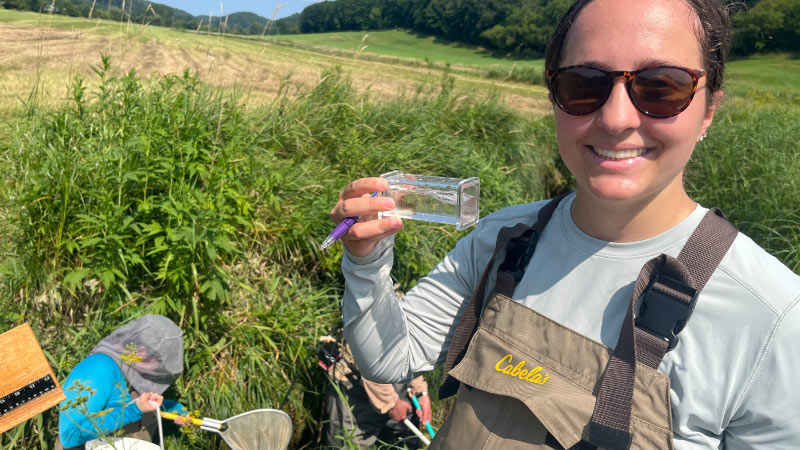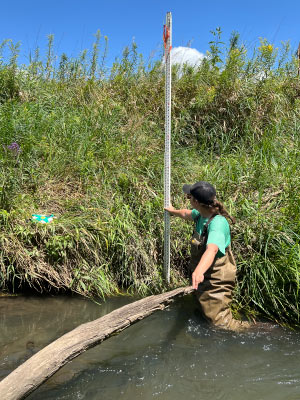
Sophie Van Alsburg has always felt a deep connection to water in all its forms. Whether she’s carving through snowy slopes in winter or diving into lakes in summer, her favorite pastimes are tied to H₂O. It was only natural, then, that her academic path would follow suit, leading her to pursue a degree in civil engineering with a focus in hydrology at the University of Washington.
Having spent much of her undergraduate experience online, Van Alsburg wanted to continue her education at a master’s level and found the Nelson Institute’s water resources management (WRM) program. “I really like the WRM program because I get to pick my own classes and make my own degree, which was my main reason for deciding to enroll,” Van Alsburg said. “I also liked the idea of getting to do a project that gives me real world experience.”
The WRM program is a 45-credit master of science degree that prepares students to face the complexities of managing water resources. Students choose an area specialty and follow a core curriculum that reflects the diversity of knowledge and interdisciplinary experience needed in water resources planning and management. To supplement the program and provide real-world experiences, students must take a summer practicum that focuses on a contemporary problem in water resources.

Van Alsburg values the interdisciplinary nature of her classes and the wide-ranging knowledge she’s gaining. One of her favorites so far has been Agroecosystems and Global Change in the agronomy department. “I have no background in agriculture at all, so it was nice to learn about that different background and understand rural water resources,” she said.
Another impactful course has been Indigenous Water and Infrastructure taught by Grace Bulltail, assistant professor of environmental studies. “I’ve really liked learning about policy and how water infrastructure has impacted indigenous communities,” Van Alsburg said. “I want to pursue water infrastructure and design as a career, so it’s great to learn about policies that I don’t get in a normal engineering degree.”
In addition to her coursework, Van Alsburg gains hands-on experience as a project assistant in the water resource engineering department, where she models future rain events in Madison to predict the impact on existing stormwater infrastructure. This real-world work allows her to apply classroom concepts directly, deepening her understanding of how changing weather patterns affect urban water systems.
This past summer, Van Alsburg had the opportunity to work in the Fancy Creek Watershed in Richland Center, Wisconsin, with the rest of her cohort as they study the groundwater and create hydrologic models for their summer project. She led her project team using the Stream Quantification Tool (SQT) which helps to quantify uplift of the creek after restoration. The Fancy Creek reconnection is one of the first projects to use the new Wisconsin SQT, and Van Alsburg’s team had the opportunity to work closely with one of its authors while conducting their research. In addition to using the SQT, Van Alsburg worked with two other students to install groundwater well transects that will inform them of how the groundwater will move once the water is redirected out of the channelized ditch to the historic meander.

As the project wraps up during the fall semester, Van Alsburg is now working on design parameters and metric estimates. Once that’s complete, Trout Unlimited will take over the monitoring portion of the project post-restoration to see any improvements in the hydrology, hydraulics, geomorphology, and biology of the Fancy Creek Watershed.
“My favorite part of this project was getting to experience working on all different aspects of the project. I helped with all the physical science parts of the project for at least a day, so I got a lot of experience in different fields outside of engineering. I especially enjoyed electrofishing and seeing the different species of fish we found in Fancy Creek and its tributaries,” she said, also noting her appreciation to the program area’s landowner who generously allowed Van Alsburg and her team to work on her property.
Reflecting on her own graduate experience thus far, Van Alsburg advises current undergraduates to make sure they have a project in mind when applying to master’s programs as they will be able to apply their experiences to their future careers. “Because of COVID-19, I never had the opportunity to do field work or any type of internship or research in my undergrad,” she said. “Getting that real-world experience is so nice because you get exposure to different kinds of workplaces that you might want to be part of.”
As for Van Alsburg’s future career, she hopes to prevent flooding and improve stormwater infrastructure that works better in a changing climate. Of course, that means ending up in a place that’s rainy and surrounded by her favorite thing: water.